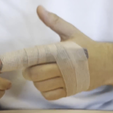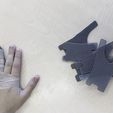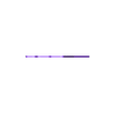Hello,
I share with you our splint design to hold a finger.
Work done by my students of STI2D ITEC (Technological Innovation and Eco Design)
Feel free to send us your remarks to improve it.
This product has not been tested by doctors yet, the stiffness and ergonomics values are not finalized yet.
If it is not stiff enough for your requirements, you will just need to increase the thickness via the Z-scale factor on your slicer.
You can print it for your own use or to give it away via associations in support of war victims. In short, do whatever you want with it as long as you don't sell it.
Manufacturing cost: 25cts (0,25€) with PLA at 20€/kg
We recommend using PLA for its ease of printing and thermoforming.
link to video
https://youtu.be/92P5s5_eMOE
The concept is inspired by this work:
https://www.printables.com/fr/model/154782-finger-brace-splint#_ga=2.35711008.1401052946.1668698817-346516111.1668698817
https://www.printables.com/fr/model/154784-finger-extension-brace-splint#_ga=2.258084234.1401052946.1668698817-346516111.1668698817
personal criticism of the latter:
- Not very comfortable and sometimes not very breathable for the skin
Here, the design is certainly not the most complex, but the trick to economy and customization is this:
To play with stiffness, vary the scale factor in Z and the part will be thicker. You can also play with the fill density. In our case, the value is 30%.
To play with the size, use the X and Y scale factor
Do not rely on the stiffness of the plate when it is flat, as it increases once the plate is formed due to the evolution of its squared moment.
The system is ambidextrous, so it is valid for the right and left hand
Slicer setting for an optimal result
Not being fans of CURA, we use Prusa Slicer, the parameterization philosophy remains the same, but the terms used may vary
The nozzle size is not important, but has a real impact on the printing time, with a 0.6 nozzle and a CR-10 volcano, I am at 20min of printing.
The plastic must be extruded very hot for the mechanical strength of the whole (at home, the PLA is extruded at 220 °)
The size of the nozzle plays a huge role on the printing time. The larger the diameter, the faster it will be and the less fine the mesh will be for the same density.
For use on the skin, which I do not recommend, it is preferable to use a 0.4mm diameter nozzle
Useless, or even deleterious, to make thick walls, as it can lead to hard areas that will result in unpleasant pressure points.
The plastic cooling fan must be active to keep the plastic in an amorphous, and therefore flexible, state.
Observe carefully our settings on Prusa Slicer present on the wrist splint design to get the desired result. No solid layer at the top or bottom, so the design is open.
Filling pattern: lines (the most efficient in time compromise, material used, comfort).
Usage procedure:
Immerse the object in boiling water
Form it directly on the patient. It will become rigid as it cools. Start by forming at the finger, making sure it is tight and not crooked.
Finish the adjustments with a hair dryer
Use a bandage to plate the splint and have an optimal fit.
Tips:
Cover the patient's hand with a thin bandage and soak it in cold water before applying the hot splint
Once formed, put a thick cloth or fleece between the skin and the splint. The plastic may become uncomfortable to wear next to the skin.
Once recovery is complete, the splint can be recycled by placing it back in warm water. It will soften and can be put back on for the next use.
Take care of yourself.
NAVARRO Antoine
MORISSE Guillaume
Students
Yann VODABLE
Mechanical engineering teacher
Lafayette High School of Clermont-Ferrand
Vice-president of the association Visière Solidaire

/https://fbi.cults3d.com/uploaders/14989567/illustration-file/8ab06f1a-0c44-47a8-a318-6d0bae54c8a3/IMG_8191.png)









